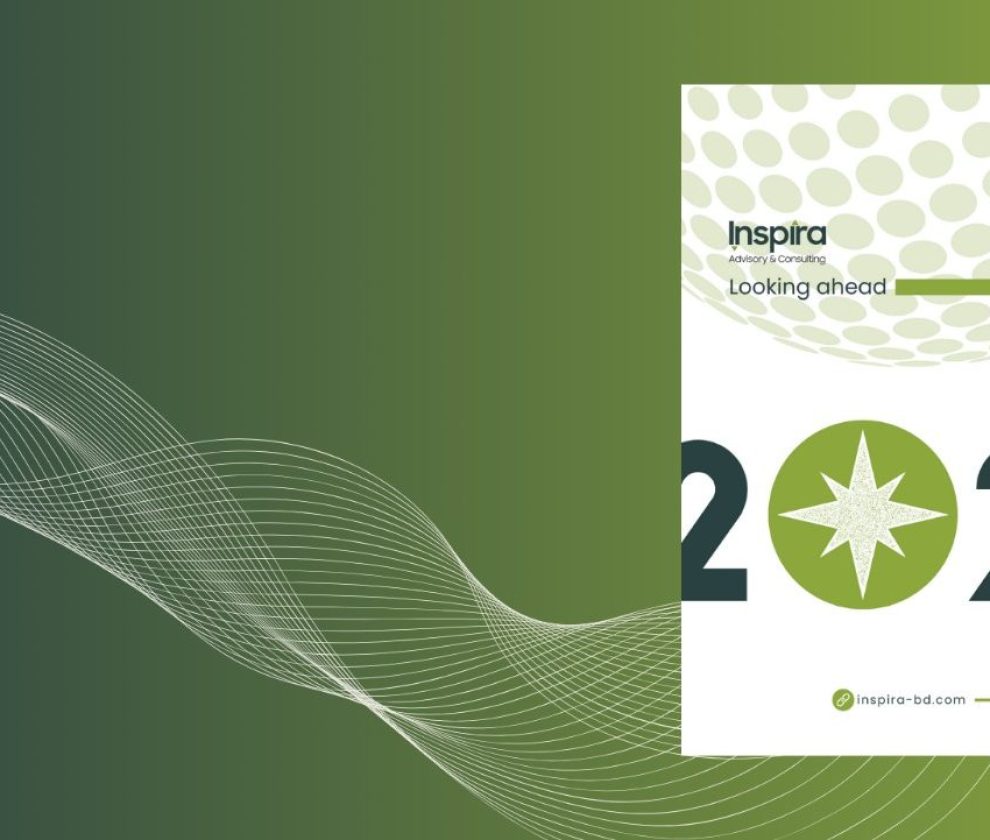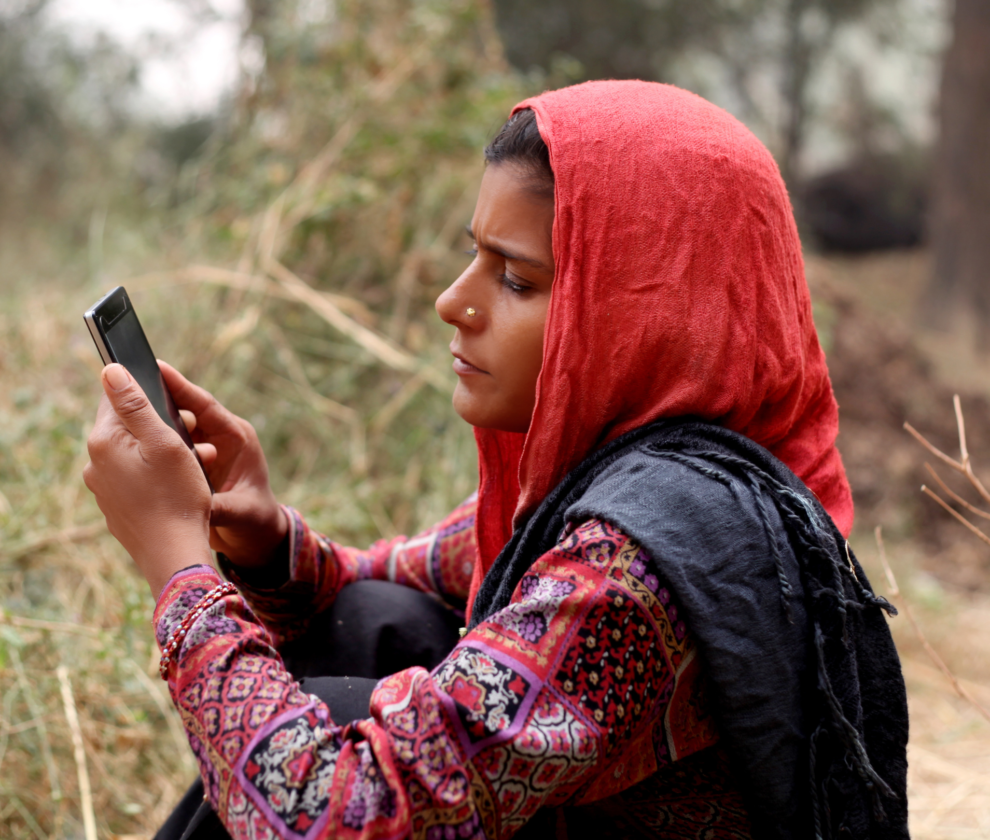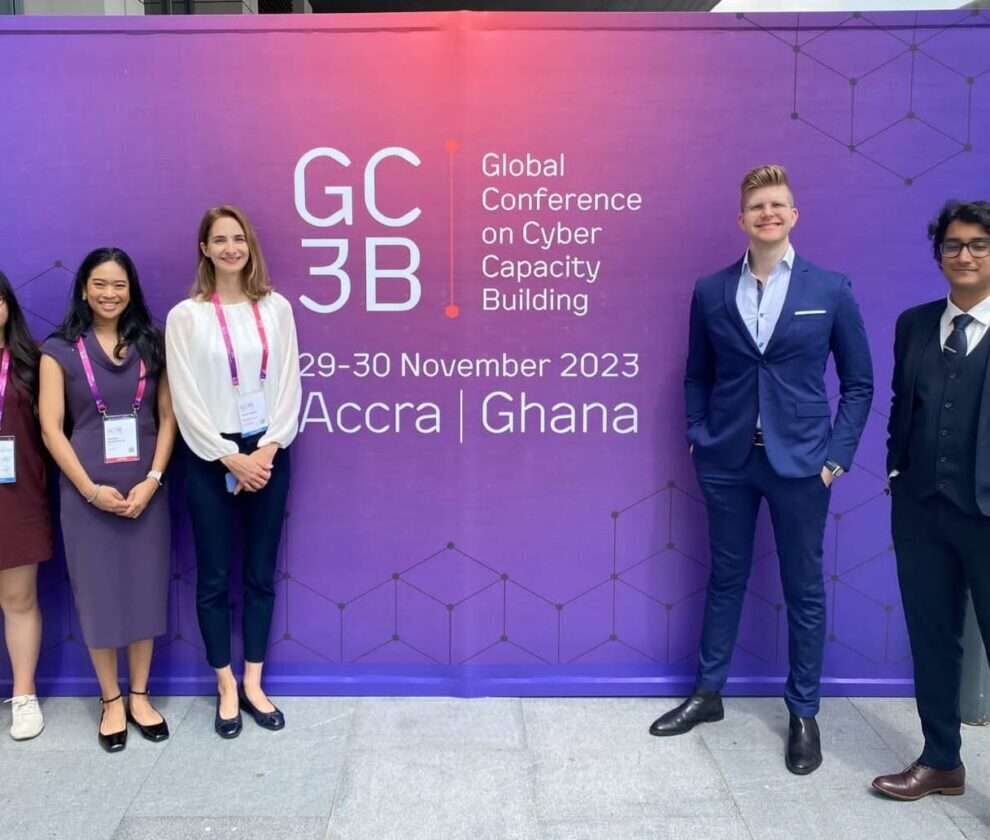Introduction
Cox’s Bazar, a coveted destination for many, is the southeastern district of Bangladesh. Outstanding infrastructural development work is going on here keeping in mind a grand philosophy and plan. A study underscores that Bangladesh has attained universal access to electricity, encompassing 100% of its population, including Cox’s Bazar (IEEFA 2023). Furthermore, substantial investments have been made in this district to empower and guarantee access to electricity for the citizens of Cox’s Bazar. Major projects such as the Matarbari Power Plant, Cox’s Bazar Wind Farm, and Joules Power Cox Bazar Solar PV Park have been initiated in Cox’s Bazar with the aim of ensuring universal access to electricity throughout the district. The district predominantly engages in agriculture (49%), with fishing and salt production the biggest sub-sectors. (ACAPS, 2020). This is closely followed by a significant service sector based on tourism (43%). Agricultural production is both scarce and more expensive than in other regions of Bangladesh, leading to increased household expenditure on food and overall economic vulnerability (REVA 2019). Livelihood activities differ across the district, with Cox’s Bazar Sadar and Chakaria home to more diverse income opportunities. Across the region, women are disproportionately engaged in low-productivity livelihood activities (such as making fishing nets, gutting fish, homestead gardening, handicrafts, etc.).
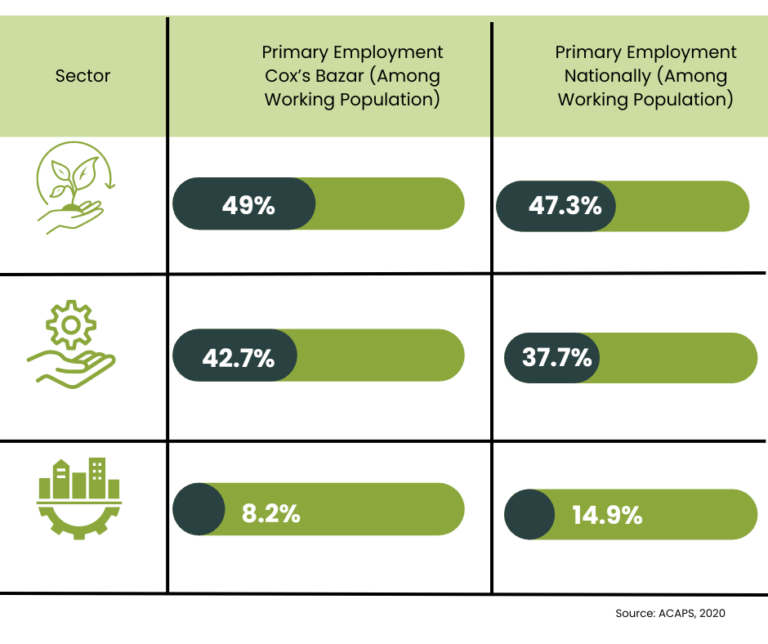
Analysis of the Key Economic Sectors
The key economic sectors of Cox’s Bazar add USD 2.75 billion per annum (excluding the multi-year, mega infrastructure projects) to the national GDP. The sectors engage a large portion of the low-income population and are well connected to the national value chain but are yet to yield higher returns due to the underdeveloped local value chains.
Tourism: The market size of the tourism sector of Cox’s Bazar stands at USD1.3 billion1 (Inspira Extrapolation, 2020). Local tourists generate more than 98 percent of tourism revenue for the sector while foreign tourists account for the rest. Each year, around 3.7 million tourists travel to Cox’s Bazar (CPSA 2019) and contribute to the growth of other cross sectors, including hotels, restaurants, transportation, and much more. One of the key sub-sectors of the tourism industry i.e. Hotels has seen an additional income stream of USD35 million per annum following the Rohingya refugee crisis by providing contractual accommodation services for the expat humanitarian workers. However, with the arrival of the Rohingya community ensuring the security of the tourists has become a major concern of the sector actors. As of 2013, the sector has employed 1 million people and most of the workers are male. BEZA (Bangladesh Economic Zones Authority) on the other hand targeted to employ .2 million local people from Cox’s Bazar by establishing three tourism parks within the next 3.5 years. Currently, Bangladesh Tourism Board, UCEP, BRAC and B-CEP are providing training programs across Cox’s Bazar district while the tourism sector entrepreneurs seem to think that there is scope for improvement in the training program design and delivery from a market-fit point of view. Besides, the current outbreak of COVID-19 caused the overall sector to lose USD3.53 million per day.
Salt: Salt is considered one of the largest labour-oriented cottage industries in Bangladesh and Cox’s Bazar accounts for 95% of the total production. The industry is divided into two major sub-sectors mainly the salt mill and salt pan. Most of the salt mills which refine the crude salt and supply finished products, are located in Chattogram and Narayanganj industrial belt. On the other side, the saltpans are overwhelmingly concentrated in Cox’s Bazar due to the availability of seawater. The sector contributes USD 150-180 million per annum from the total production of 18.24 lakh metric tonnes of crude salt in 2019. A total of 64,000 acres of land have been brought under salt cultivation but currently, salt has been produced across 60,596 acres of land. Among the seven salt-farming cultivating areas, Moheshkhali Upazila has the highest concentration of salt farmers. At least 28,791 people from seven upazilas of Cox’s Bazar are working in the sector. The sector has a high potential to absorb the nearby local population (Kutubdia, Moheshkhali, Teknaf etc.) of Cox’s Bazar, while the inclusion possibility of females and persons with disabilities is limited as of now. Government megaprojects, on tourism sector market size calculation, extrapolated as the annualization of the ‘Per Day Revenue’ figures collected from the Tour Operators Association of Cox’s Bazar. The amount is the combined revenue of Bus, Hotels, Restaurants, Airplane, Photographers, and small businesses. Salt Sector Market Size Calculation: Calculated as the product of the Annual Production of Salt and Price Per Maund figures were collected from the Bangladesh Government information website. the other hand, are also leading to a loss of land and making farmers withdraw from salt farming activities.

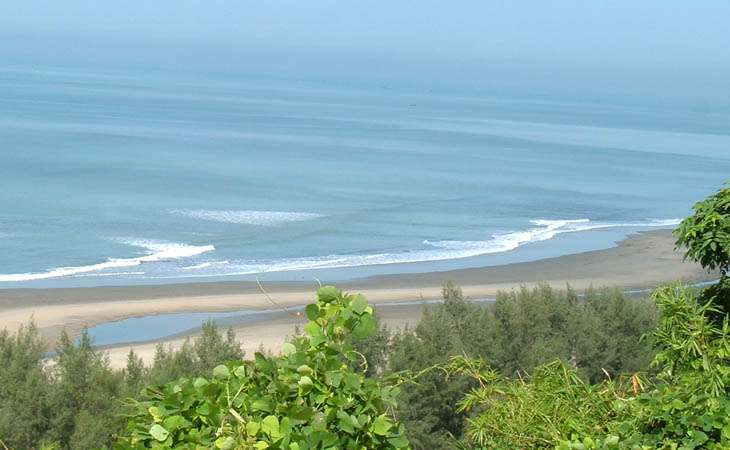
Dry Fish: Cox’s Bazar has a long history of dry fish production, and holds a key stake in meeting the domestic dietary protein demand and export earnings. The sector contributes USD 40 million to the national dry fish sector in FY 2019-20. The national dry fish export stood at USD 5.285 million in FY 2017-2018 where around 100 dedicated export processing yards of Cox’s Bazar played a pivotal role. After the Rohingya influx, dry fish consumption increased manifolds as dry fish is one of the common foods among refugees. The sector employs 40,000 to 50,000 thousand direct workers, where women’s inclusion is high. The efficiency of the drying process can sometimes be disrupted when fish become infested by insects. Although some processors use salt to prevent insect infestation, some dry fish processors resort to using harmful chemicals. Improved drying technology in fish drying is being adopted slowly but a number of challenges are hindering the overall progress including lack of electricity supply, lower profit margin, high capital requirements etc. The government and donor community undertook several development initiatives to cater for the growth of the sector. Although at a nascent stage, dry fish sales through e-commerce have gained popularity among Dhaka-based middle and affluent-class consumers.
Crop: Most of the common crops produced in the area are different types of rice, betel nuts, ground nuts, sugar cane and ripe mustard. However, the crop that Cox’s Bazar excels at is Betel Nuts, Cox’s Bazar is currently the second largest producer of Betel nuts in the country accounting for more than 17% of the national production. In Teknaf, farmers have switched from betel nut to betel leaf farming due to its profitability. Now, Teknaf contributes about 80% of the country’s betel leaf output, with an additional 5,000 hectares devoted to cultivation in the last three years..The total crop production in 2018-19 was 496,271 metric tonnes, while the total production of vegetables was 15,876 metric tonnes. The total crop production in 2018-19 was 496,271 metric tonnes, while the total production of vegetables was 15,876 metric tonnes. The total (estimated) market size for crops from the district stands at USD 192 million for the year 2018-19. The current employment engagement by the agriculture sector in Cox’s Bazar stands at 289,220. Marine Fish Capture: Cox’s Bazar being a coastal region has made marine fish capture one of the key sectors. The region earned USD 841.37 million from the marine fish sector (Inspira Extrapolation, 2020). Artisanal fisheries contribute 87.07 percent whereas industrial fisheries contribute the rest. The sector employed more than 48,393 registered fishers in Cox’s Bazar whereas 5,15,000 people are working as registered artisanal fishers. inclusion of the female workforce in the marine fishing workforce is limited as of now due to socio-cultural constraints. While we have 1,18,813 sq km of sovereign sea for fishing, Bangladeshi trawlers and fishing boats cannot go beyond 200 nautical miles owing to the lack of deep-sea fishing instruments, vehicles and skill.

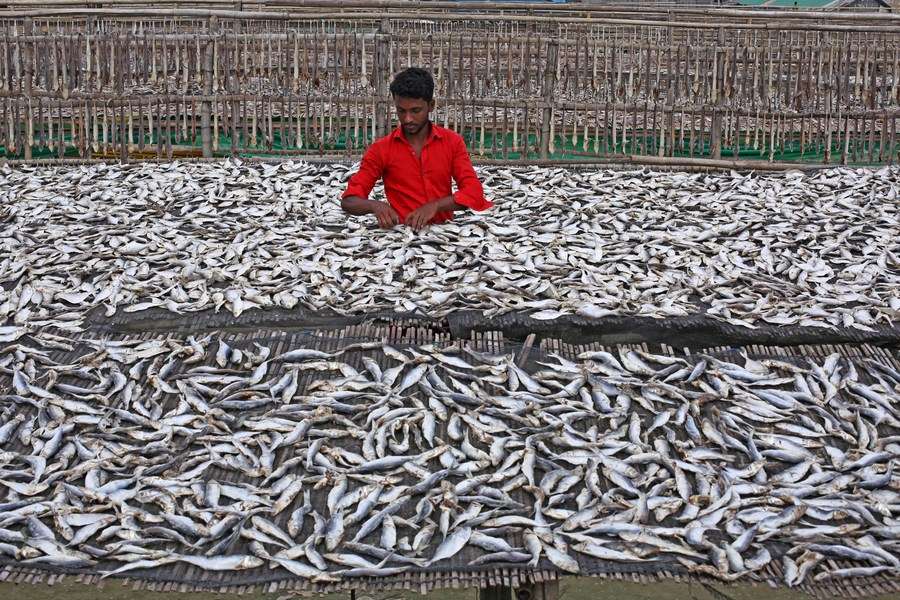
Shrimp: Shrimp is the third largest source of export earnings of Bangladesh, Export earnings from frozen shrimp, which is the key item of the sector, were $300.26 million in FY23 and $407.25 million in FY22.valued at around USD 408 million in FY 2018-19. Cox’s Bazar plays a major role in the national shrimp sector where some 55 marine shrimp hatcheries at various stages of operation are supplying over 15 billion shrimp broodstock and post larvae each year. Located in the marine drive road Cox’s Bazar shrimp hatchery zone is the country’s only production hub of shrimp post-larvae. Most shrimp processing farms are located in the Khulna belt; therefore, shrimp PL is transported from Cox’s Bazar to Khulna frequently by air. The sector employs around 43,000 people in Cox’s Bazar. The shrimp sector in Cox’s Bazar is passing through a challenging phase as shrimp export from Bangladesh (from Khulna-based processing zones, who are the forward market actors of the stakeholders in Cox’s Bazar) is declining. Around 50% of the hatcheries have closed their operation and many are struggling to continue. The coronavirus pandemic has slowed down the growth of the sector as almost 26 hatcheries are able to continue their operation while others had to shut down their activities, losing more than 2 billion shrimp PL.
Livestock: Livestock is currently making up a large portion of the local economy currently producing USD 220.65 million worth of dairy and poultry produce. However, there is still scope for expansion as the current market demand stands at USD 376.91 million. There is high engagement in this sector due to the cultural practices of the country. However, it is difficult to estimate the actual figures in terms of employment generated as for many this is not the primary occupation. Other than some commercial farms, the methods applied in this sector are traditional and the average person is unaware of the advancements in animal health, inputs and feeds and techniques and practices which boost output. Disease and subsequent losses are also common in this sector which reduces productivity. Additionally, the sector has been hit hard by the refugee influx and its aftermath, primarily in the form of loss of grazing land and sales of cattle and poultry to cover living expenses following job loss in the host community (also a result of the influx).
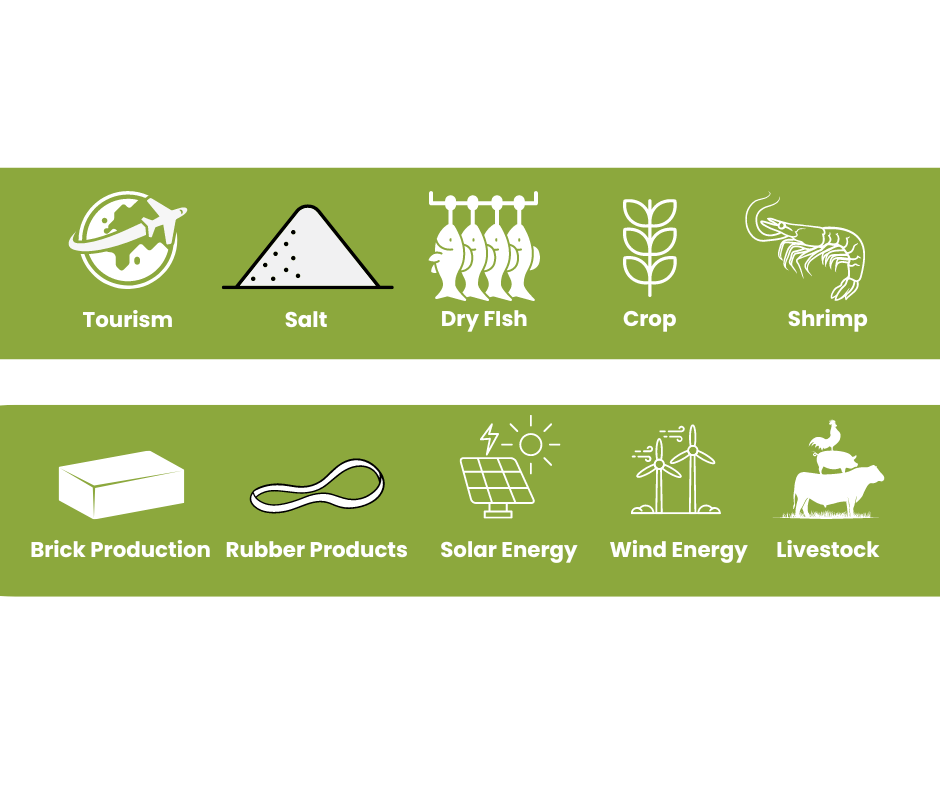
Solar Energy: Cox’s Bazar is considered a preferable region to develop utility-scale commercial solar plants as it has a massive amount of non-agricultural fallow land with a good amount of solar irradiance. Joules Power Cox Bazar Solar PV Park is a 28MW solar PV power project. The project generates 43,000MWh electricity thereby offsetting 20,000t of carbon dioxide emissions (CO2) a year. The establishment of the Matarbari Solar PV Park, a new solar photovoltaic project with a production capacity of 409 MW, has been announced. Construction is scheduled to commence in 2025, with commercial operations expected to begin in 2027.A 20 MW solar plant has been established recently which is covering the entire demand of Teknaf. Another 200 MW solar plant is under planning in Teknaf. Recently UNHCR has planned to provide p2p shared solar home systems in the Rohingya camps. It has a huge potential to increase the life and livelihood of refugees. Cox’s Bazar can be developed to attract the private sector in mobilizing investment in clean energy in meeting the country’s overarching goal of generating 10% energy from renewable sources.
Wind Energy: Cox’s Bazar coastal belt is one of the suitable regions for commercial wind energy production as it has the highest average wind speed of 5.75-7.75 m/s. However, due to its sub-tropical climate, Cox’s Bazar has periodically high wind speed (top speed over 35 m/s) during the typhoon season, which is the biggest constraint in attracting investment in the sector. Wind Power Plant of Cox’s Bazar which has the production capacity of 60MW has initiated it’s commercial operation in 8th March 2024. It has turned out to be a game changer for Bangladesh – a densely-populated country with limited availability of land – by producing a remarkable 60MW using just 7.5 acres. The Matarbari Power Plant, currently under construction, is projected to have a production capacity of 1,200 MW. The Coal Power Generation Company has commenced trial production of 600 MW from the plant’s first unit, which contributes to the total planned capacity of 1,200 MW.A 60 MW wind power plant is under construction in Cox’s Bazar and the government floated a tender to build another 50 MW plant in Inani. There is a huge potential for building a small-scale windmill beside the Marine Drive road located in Cox’s Bazar and supplying cheap electricity to the rural communities that are currently excluded from the grid supply.
Rubber goods: In Ramu Cox’s Bazar, there is a large rubber garden which is one of the oldest in Bangladesh and has a history of supplying rubber in the domestic market. The garden constitutes 2,682 Acres of land with around 86,000 productive and more than 150,000 unproductive/growing rubber trees. The garden produced 215 Metric Tons of rubber in FY 2020-2021. The total number of employees working in the rubber garden is 30; among them, 15 are employed under ‘Pay commission’, and the other 15 are under wage employment. (2021)The rubber garden has spread across 2,662 acres of land where more than 94,000 rubber trees are actively producing around 250,000 KG of rubber per annum which is a key stake in meeting 60% of the national demand. The country’s total rubber production is constantly declining due to the decline of prices in the domestic market and the dominance of imported products. Local contractors deploy around 300 labourers (daily wage-based) during the peak season (September January) and around 200 labourers during the off-peak season (February-August).
Brick production: The rapid boom of tourism-driven construction and ongoing infrastructure development projects has increased the demand forof bricks in the district. According to the DOE, there are 109 brick kilns in Teknaf, Chakaria, Cox’s Bazar Sadar, Eidgaon, Ramu, and Pekua upazila of Cox’s Bazar. Of them, five are closed and 54 do not have any legal grounds to operate. Besides, 31 of these have been built on reserved forest and hilly areas operating for 5 to 15 years. (03 Apr 2022)Cox’s Bazar has approximately 83 brick fields, which use the topsoil of agricultural land and pose a huge environmental threat in the region. Mostly located in Ramu, Ghundhum and Cox’s Bazar Sadar area, each brick field produces 2.5-3 million bricks per year using more than 60 million cubic feet of topsoil. Local farmers are motivated to sell topsoil at a lucrative price, and they are participating without knowing the dangerous future consequences. Moreover, they are using traditional technology which is banned and uses wood for burning. Hence, it also raises concern over air pollution and its negative impact on the local wildlife sanctuaries.
Upazilawise Economic Profile
Upazila | Macro Outlook | Livelihood/Income dynamics |
Cox’s Bazar Sadar | The most prominent urban municipality in the district with the lowest poverty and extreme poverty headcount ratios in the district On-going inward migration to escape the extreme impacts of climate change on surrounding coastal areas and islands. | 70% of the economy is based on service and trade-based activities (i.e. hospitality, fisheries-related labour and trading, tourism SMEs (WFP 2020). Most work is informal, consisting of moderate to low-skilled jobs and petty trade for low wages (REVA 2019). |
Chakaria | The biggest upazila, second lowest poverty headcount and extreme poverty headcount ratios in the district Chakaria is the first point of entry by road into Cox’s Bazar the district from the rest of the country has the largest transportation network in the district (UNDP, 2018) | Engages primarily in rice cultivation in the flatlands (UNDP, 2018). salt water from the sea continues to destroy soil quality, resulting in more common shrimp farming. Tobacco farming in the hills of Chakaria> environmental threat due to deforestation in the hill. |
Kutubdia | An island in the sea that has halved in size over the last 20 years due to rising water levels, sea-bed erosion, and produced large-scale climate migration to the nearby urban centres (BBC 2015) Only 7% of households with access to electrification (the lowest in the district), rendering the population even more isolated. (The Daily Star, 2016) | Agriculture and fishing are the primary sources of income. Seabed erosion continuously decreases the amount of available land The local population has reported that fishing is no longer viable in shallow waters as warming waters have resulted in decreased yield many fishermen have resorted to deep-sea fishing, which is limited to only a few months a year due to depressions and cyclones in the Bay of Bengal. |
Maheshkhali | An island upazila with the highest poverty and extreme poverty headcount ratios in Cox’s Bazar Moheshkhali-Matarbari integrated infrastructure development initiative: a deep seaport, four units of coal- fired power projects an LNG-based power plant underway. | Most households earn their income from salt production, shrimp and crab farming, fishing, agriculture, and day labour (often in the aforementioned occupations). Unemployment rate may increase in future across traditional IGAs: The plants will likely negatively impact marine habitats and affect coastal fishing. (Start Fund Bangladesh 2018) |
Pekua | has poverty and extreme poverty headcount ratios of 30.9% and 14.3% respectively, slightly lower than the national average. Highly vulnerable to flood damage due to its low-lying nature and high rate of kutcha housing (78.40%), the highest in the district (Alam 2019) | Between 60% and 72% of the population is engaged in agriculture as their primary source of income, which is much higher than the rest of Cox’s Bazar district (UNDP 2018) Like other upazilas, most (62%) of the population working in agriculture is landless (Bangladesh Population Census, 2011). |
Ramu | The presence of comparatively substantial religious minority groups Shares a border with Ukhiya, and therefore there is the presence of some Rohingya refugees (UNDP 2018). | Most of the population relies on daily wage labour, with nearly 56% engaged in agriculture followed by rickshaw pulling & construction. Livelihoods are prone to natural disasters such as cyclones, flash floods, river erosion, and landslides |
Teknaf | Ranks among the 50 most socially deprived Upazilas in the country. The fishing ban in the Naf River pushed many households into debt as they lacked alternative livelihood opportunities coupled with a lack of cultivable lands. Human trafficking is prevalent in Cox’s Bazar, with well-known transit areas in Teknaf (IOM, 09/2018). | Teknaf has the lowest literacy rate in Cox’s Bazar district (26%) (District Statistics, 2011) and a high incidence of child labour (7-9%) (UNICEF, 01/2014) 82% of Teknaf’s total income is from fish and fishery-related activities such as shrimp cultivation and the dry fish industry (Ghosh et al, 12/2015). |
Ukiya | third highest poverty headcount and second highest extreme poverty headcount ratios in Cox’s Bazar Difficult terrain, bad roads, and insufficient infrastructure contribute to poor living conditions and access to essential services | 55% of the population is engaged in the agricultural sector, 85% of households reported their main source of income from labor Increase in income for people engaged in small trading shops, tea and food stalls, and other service sector activities (StCUNHCR, 01/2018). |


Conclusion
The economic landscape of Cox’s Bazar presents a complex tapestry of challenges and opportunities. Despite being a district with immense potential, evidenced by its significant contributions to national GDP through sectors like tourism, salt production, and fisheries, Cox’s Bazar faces persistent developmental gaps. The district’s high poverty rate, inadequate access to basic amenities like electricity and sanitation, and underdeveloped local value chains underscore the urgent need for targeted investment and strategic interventions.
Key sectors such as tourism, salt production, and fisheries have shown resilience and promise, yet they grapple with issues ranging from security concerns in tourism to sustainability challenges in salt farming and shrimp processing. Moreover, traditional sectors like agriculture and livestock, while culturally significant, require modernization and improved practices to realize their full potential.
Efforts to harness renewable energy sources like solar and wind power represent a forward-looking approach to economic development in Cox’s Bazar, with the potential to not only meet local energy needs but also drive broader socio-economic transformation.
Moving forward, addressing the district’s development disparities will necessitate a multi-dimensional strategy that includes targeted investment in infrastructure, technology, and human capital. This approach should prioritize inclusive growth, gender equality, and environmental sustainability to unlock Cox’s Bazar’s full economic potential and improve the well-being of its residents. Collaboration among government agencies, private sector stakeholders, civil society organizations, and development partners will be critical in catalyzing positive change and realizing a more prosperous future for Cox’s Bazar.


